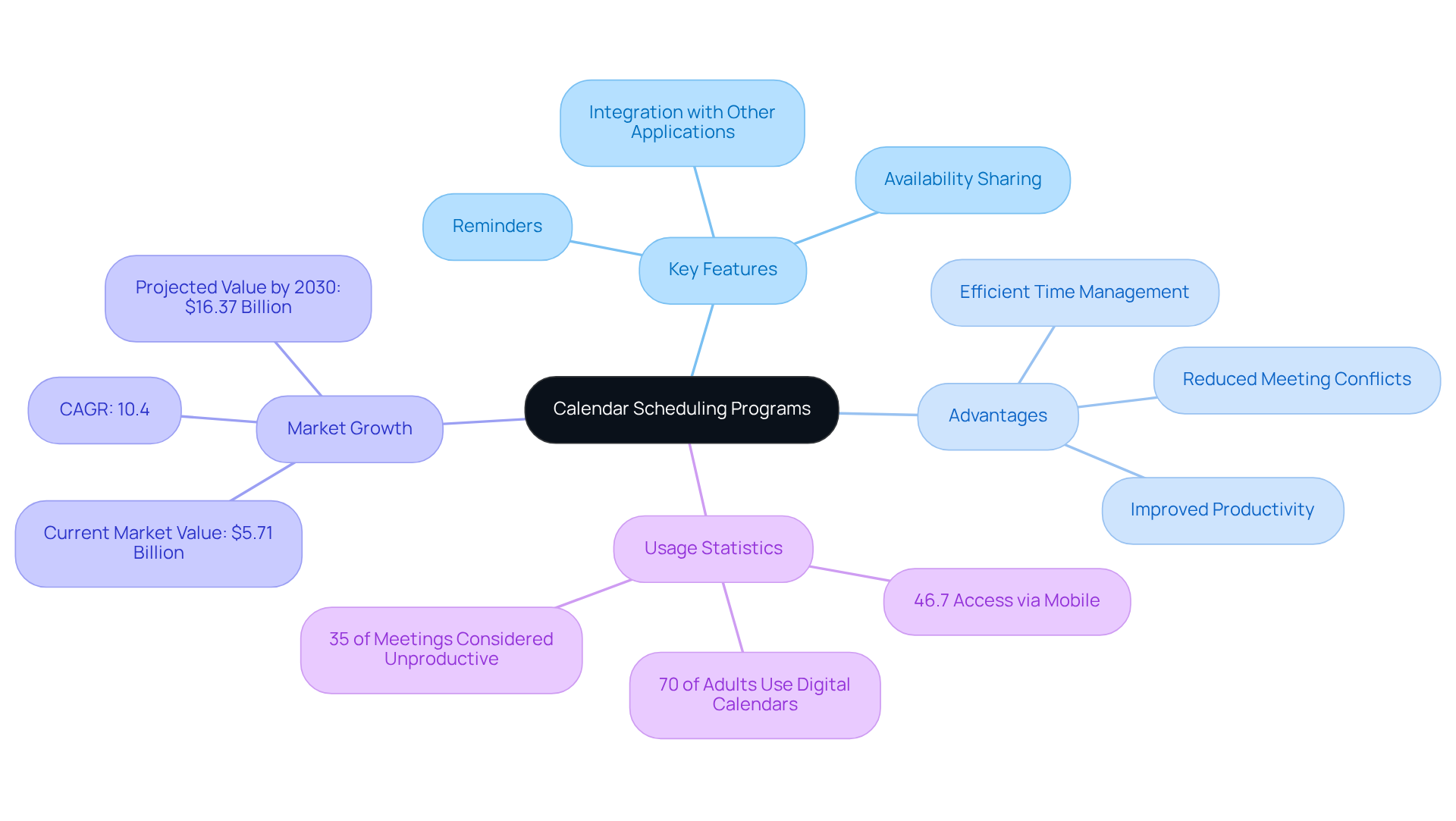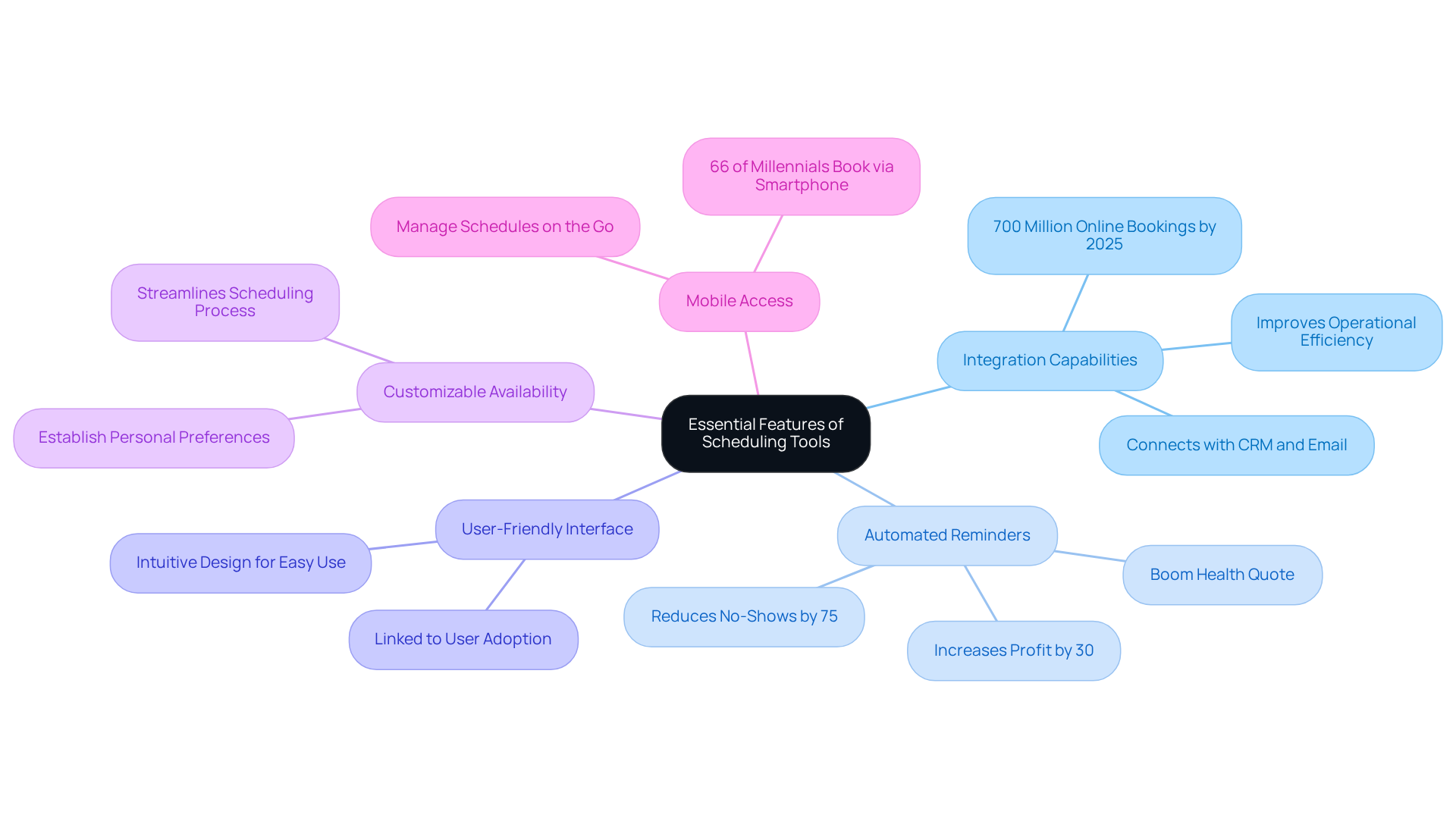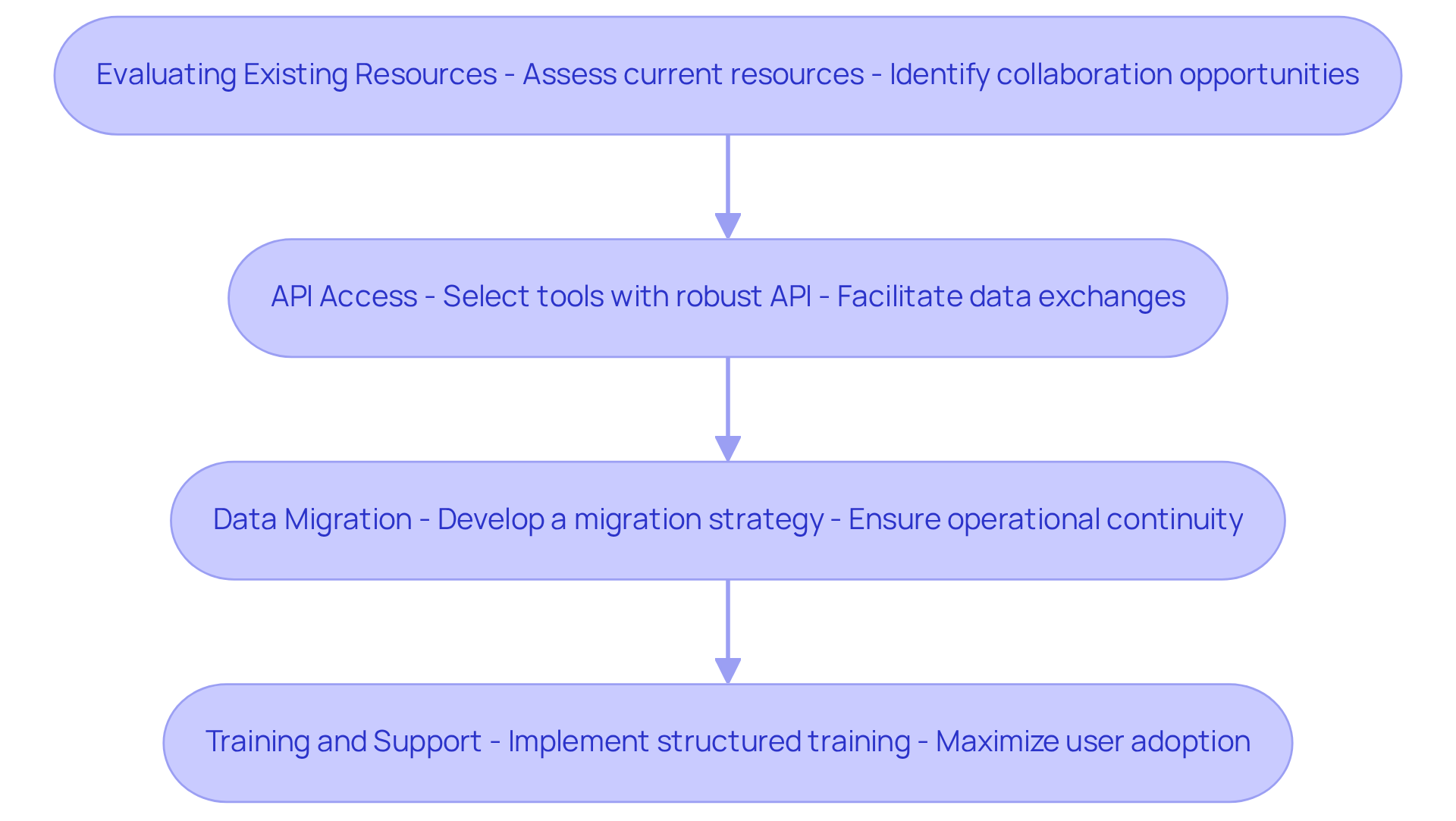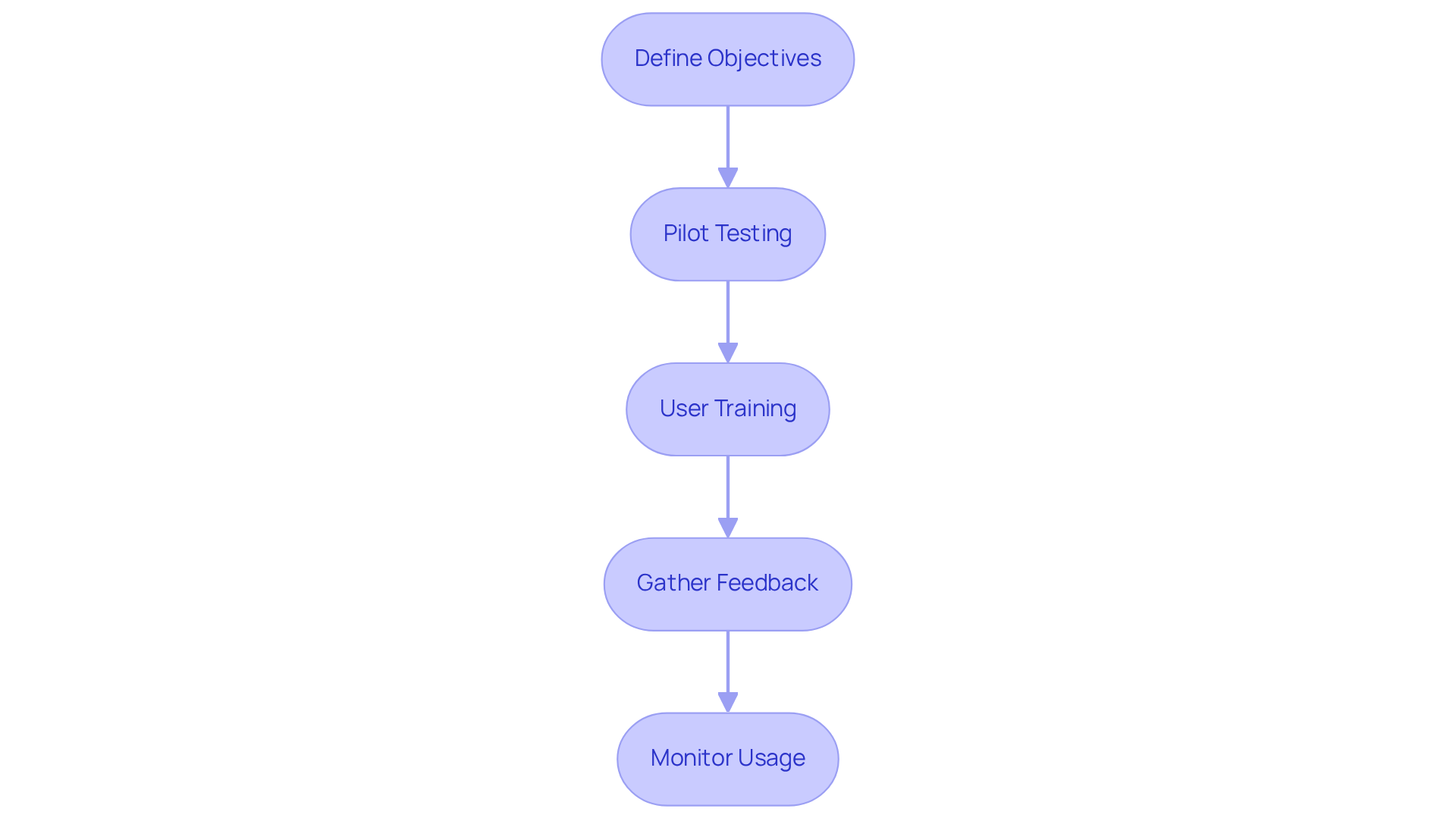4 Best Practices for Effective Calendar Scheduling Programs

Overview
The article highlights the critical need for effective calendar scheduling programs, addressing the prevalent issue of communication inefficiencies within organizations. By focusing on essential features such as integration capabilities, automated reminders, and user-friendly interfaces, it builds a compelling case for the adoption of these tools. The benefits of implementing well-designed scheduling solutions are clear: they can significantly enhance organizational productivity and streamline communication.
Moreover, the article outlines actionable steps for successful implementation, reinforcing the idea that these tools are not just beneficial but essential in today’s fast-paced business environment. By showcasing the unique features of effective scheduling programs, it creates a desire for organizations to explore these solutions further, ultimately prompting them to take action towards improving their operational efficiency.
In conclusion, the article supports the notion that adopting advanced scheduling tools is a strategic move that can lead to substantial improvements in productivity and communication. Organizations are encouraged to consider these insights and explore the potential of well-designed scheduling programs to transform their operational landscape.
Introduction
In today’s fast-paced work environment, efficient time management stands as a cornerstone of productivity, particularly as the average professional navigates multiple meetings each day.
Calendar scheduling programs have emerged as indispensable tools, streamlining appointment organization and enhancing collaboration across teams.
By delving into the essential features and best practices for implementing these digital resources, organizations can unlock substantial improvements in operational efficiency.
Yet, with a plethora of options available, how can one discern the most effective approach to seamlessly integrate these tools into existing workflows?
Understand Calendar Scheduling Programs
Calendar scheduling programs are essential digital tools that empower individuals and organizations to manage their time efficiently. By centralizing the organization of meetings, appointments, and tasks, calendar scheduling programs significantly reduce the disorder that comes with juggling multiple calendars. Key features such as reminders, availability sharing, and seamless integration with other applications make calendar scheduling programs indispensable for effective time management.
The advantages of using calendar scheduling programs as digital management resources are substantial. For instance, Google Calendar and Outlook Calendar not only enable users to set appointments but also facilitate the sharing of availability, thereby simplifying the process of arranging meetings. This capability is particularly crucial in today’s work environment, where one-third of all meetings span multiple time zones, underscoring the need for efficient coordination.
Moreover, the calendar app market is currently valued at $5.71 billion and is projected to grow at a compound annual growth rate (CAGR) of 10.4%, reaching an estimated value of $16.37 billion by 2030. This growth indicates a rising dependence on digital resources for time management, as 70% of adults now utilize calendar scheduling programs to organize their lives, with approximately 1 in 2 individuals accessing these programs on their phones. Understanding how calendar scheduling programs operate and their numerous advantages is the first step toward utilizing them effectively within any organization, ultimately leading to improved productivity and fewer time conflicts.
Furthermore, with 46% of professionals participating in three or more meetings daily and 35% of gatherings deemed unproductive, the necessity for efficient calendar scheduling programs becomes even more apparent. Embracing these digital solutions is not just an option; it is imperative for enhancing operational efficiency and communication.

Identify Essential Features of Scheduling Tools
When selecting calendar scheduling programs, it is vital to identify essential features that align with your organizational needs. Key features to consider include:
-
Integration Capabilities: The capacity to connect with current resources (such as CRM systems, email platforms, and project management software) is vital for a smooth workflow. Organizations that prioritize integration often report improved operational efficiency and enhanced user satisfaction. Notably, over 700 million individuals are expected to book appointments online by 2025, highlighting the growing importance of this feature.
-
Automated Reminders: Automated notifications are crucial in reducing no-shows. Studies indicate that reminders can decrease these rates by up to 75%. As noted by Boom Health, “reminding your customers of their upcoming appointments can reduce no-shows by up to 75% and thus bring in up to a 30% increase in profit,” ensuring that everyone stays informed about upcoming meetings.
-
User-Friendly Interface: A simple and intuitive design ensures that all team members can utilize the resource effectively without extensive training. User adoption is often linked to ease of use, making this a top priority for successful implementation.
-
Customizable Availability: Users should be able to establish their availability and preferences, allowing for more efficient planning. This flexibility not only streamlines the process but also accommodates the diverse needs of team members.
-
Mobile Access: With the increasing need for flexibility, mobile access ensures that users can manage their schedules on the go. Significantly, 66% of millennials book their travel arrangements via a smartphone, emphasizing the importance of mobile features in planning applications.
By focusing on these features, organizations can choose calendar scheduling programs that not only meet their current needs but also adapt to future requirements. Furthermore, it is crucial to account for typical pitfalls, such as ensuring adherence to privacy regulations like GDPR and CCPA, to make informed choices when selecting planning software.

Ensure Integration with Existing Systems
To fully harness the advantages of calendar scheduling programs, seamless integration with existing systems is essential. This endeavor encompasses several pivotal practices:
-
Evaluating Existing Resources: Conduct a thorough assessment of the resources currently utilized within the organization to pinpoint potential collaboration opportunities. This evaluation not only identifies gaps but also highlights areas ripe for improvement.
-
API Access: Select planning tools that provide robust API access. This capability enables personalized connections with other software solutions, facilitating smoother data exchanges and enhancing overall functionality.
-
Data Migration: Formulate a comprehensive strategy for migrating data from legacy systems to new platforms. This crucial step safeguards against the loss of vital planning information and ensures operational continuity. As industry experts indicate, challenges in data migration can surface, underscoring the necessity of a well-defined strategy.
-
Training and Support: Implement a structured training program for staff to familiarize them with the new resources and their integration with existing systems. Adequate support during this transition is vital for maximizing user adoption and minimizing disruptions.
Integrating calendar scheduling programs with a project management system can significantly streamline task assignments and meeting scheduling, ensuring that all team members remain aligned and informed. This combination not only enhances efficiency but also fosters improved communication among teams, ultimately resulting in superior project outcomes. Moreover, research indicates that 59% of organizations cite integrations as instrumental in enhancing their close rates, underscoring the tangible benefits of effective systems integration.

Implement Scheduling Programs Effectively
Implementing scheduling programs effectively involves several key steps:
- Define Objectives: Clearly outline what the entity aims to achieve with the new scheduling system, such as reducing scheduling conflicts or enhancing communication.
- Pilot Testing: Before a full rollout, conduct a pilot test with a small group of users to gather feedback and make necessary adjustments.
- User Training: Provide comprehensive training sessions to ensure all users are comfortable with the new system and understand its features.
- Gather Feedback: After implementation, continuously gather user feedback to identify areas for improvement and address any challenges.
- Monitor Usage: Regularly observe how the tool is being utilized to ensure it meets the company’s needs and to identify any additional training requirements.
By following these steps, organizations can ensure that their scheduling programs are not only implemented successfully but also adopted widely, leading to enhanced productivity and operational efficiency.

Conclusion
Effective calendar scheduling programs are not merely beneficial; they are essential for enhancing time management and operational efficiency in both personal and organizational contexts. In an era where communication inefficiencies can hinder productivity, leveraging these digital tools allows users to streamline their scheduling processes, minimize conflicts, and foster better communication. The result? A significant boost in productivity.
This article outlines essential practices for selecting and implementing calendar scheduling programs. Key features include:
- Integration capabilities: Ensuring compatibility with existing systems.
- Automated reminders: Keeping users on track.
- User-friendly interfaces: Facilitating ease of use.
- Customizable availability: Meeting diverse user needs.
- Mobile access: Enabling scheduling on the go.
Moreover, the importance of seamless integration and effective implementation strategies cannot be overstated, as these elements are fundamental to maximizing the benefits of scheduling software.
In a world where time management is increasingly critical, embracing effective calendar scheduling practices is not just advantageous; it is essential. Organizations and individuals alike must prioritize the adoption of these tools to navigate the complexities of modern scheduling, enhance collaboration, and ultimately achieve greater success. By investing in the right scheduling solutions and following best practices, the potential for increased efficiency and productivity is significant, paving the way for a more organized and successful future.
Frequently Asked Questions
What are calendar scheduling programs?
Calendar scheduling programs are digital tools that help individuals and organizations manage their time efficiently by centralizing the organization of meetings, appointments, and tasks.
What are the key features of calendar scheduling programs?
Key features include reminders, availability sharing, and seamless integration with other applications, which collectively enhance effective time management.
How do calendar scheduling programs facilitate meeting arrangements?
Programs like Google Calendar and Outlook Calendar allow users to share their availability, simplifying the process of arranging meetings, especially important in environments where meetings often span multiple time zones.
What is the current market value of calendar apps and its projected growth?
The calendar app market is currently valued at $5.71 billion and is projected to grow at a compound annual growth rate (CAGR) of 10.4%, reaching an estimated value of $16.37 billion by 2030.
How prevalent is the use of calendar scheduling programs among adults?
Approximately 70% of adults utilize calendar scheduling programs to organize their lives, with about 1 in 2 individuals accessing these programs on their phones.
Why are calendar scheduling programs important for professionals?
With 46% of professionals attending three or more meetings daily and 35% of those meetings deemed unproductive, efficient calendar scheduling programs are crucial for enhancing operational efficiency and communication.
What benefits do organizations gain from using calendar scheduling programs?
Utilizing calendar scheduling programs leads to improved productivity and fewer time conflicts within organizations, making them essential for effective time management.
